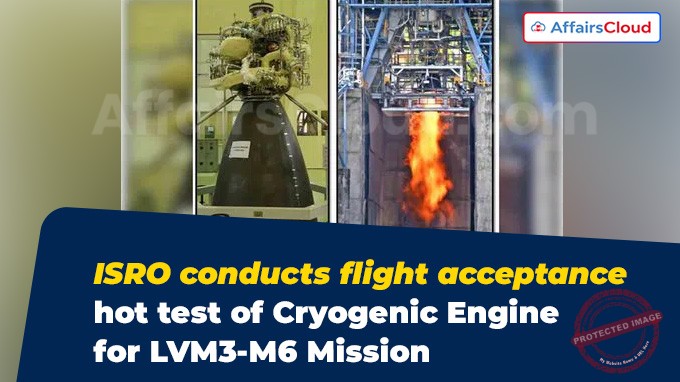 In March 2025, Bengaluru (Karnataka)-based Indian Space Research Organisation (ISRO) has successfully conducted the flight acceptance hot testing of the indigenous cryogenic engine(CE20) identified for the 6th operational mission of the LVM3 launch vehicle (LVM3-M6) at the ISRO Propulsion Complex (IPRC) in Mahendragiri, Tamil Nadu (TN).
In March 2025, Bengaluru (Karnataka)-based Indian Space Research Organisation (ISRO) has successfully conducted the flight acceptance hot testing of the indigenous cryogenic engine(CE20) identified for the 6th operational mission of the LVM3 launch vehicle (LVM3-M6) at the ISRO Propulsion Complex (IPRC) in Mahendragiri, Tamil Nadu (TN).
- It is mandatory that cryogenic engines for every mission will undergo hot testing as part of its acceptance for the flight.
Key Points:
i.In the latest test, the engine was fired for an maximum duration of 100 seconds for the 1st time under non-vacuum conditions using Nozzle Protection System.
- This test method has significantly reduced the setup time and effort needed for flight acceptance testing, thus faster delivery of cryogenic stages.
- Previously, these hot tests for the indigenous cryogenics were performed at the High-Altitude Test (HAT) facility at IPRC, where vacuum conditions are simulated with complex conditions, limiting the maximum time duration for hot test to 25 seconds.
ii.As per ISRO, the CE20 engine has achieved all test objectives/targets and will now be integrated into Cryogenic Upper Stage of LVM3-M6 launch vehicle, which will be launched in the second half of 2025.
About LVM3:
i.It is previously known as Geosynchronous Satellite Launch Vehicle (GSLV Mk-III), a 3-stage mid-lift launch vehicle consisting of two solid propellant S200 straps-ons and core stages comprising of L110 liquid stage.
ii.The height and diameter of the vehicle is 43.5 meter (m) and 4.0 m respectively, with lift-off mass of 640 tonnes.
iii.The vehicle has the capacity to launch heavier communication satellites that weigh up to 4,000 kilogram (kg) in Geosynchronous Transfer Orbit (GTO).
GoI Approved Chandrayaan-5 Mission: ISRO Chairman
In March 2025, V. Narayanan, chairman of ISRO announced that the Government of India (GoI) has approved the ‘Chandrayaan-5/ Lunar Polar Exploration Mission(LuPEX)’ mission at an event held in Chennai, TN. For this mission, GoI has collaborated with Japan.
- The mission will be launched as part of building capability towards achieving the target of an Indian landing on Moon by 2040.
- He further announced that India will have its own space station, ‘Bharatiya Antriksh Station’ by 2035.
About Chandrayaan-5:
i.The mission will feature a 350 kilogram (kg) rover, which marks a significant increase from the 25 kg ‘Pragyan’ rover used in the Chandrayaan-3 mission.
ii.It is being designed to show the higher capacity lander, which is a crucial element for future landing missions, including human landings on the surface of the moon.
Background:
i.The Chandrayaan programme has played a pivotal role in India’s lunar exploration. Chandrayaan-1, India’s 1st lunar mission was launched in 2008, mapped the lunar surface chemically, mineralogically and photo-geologically.
ii.In 2019, ISRO launched Chandrayaan-2, which was 98% successful but faced setbacks during its final stages.
iii.Chandrayaan-3 launched in 2023 which had successfully demonstrated India’s ability to achieve a soft landing on the moon’s south pole.
iv.In 2024, the GoI approved the Chandrayaan-4 mission which will be launched in 2027. It aims to show the capability of landing on the Moon and the safe return to earth, including technologies for sample selection.
About Indian Space Research Organisation(ISRO):
Chairman- V. Narayanan
Headquarters– Bengaluru, Karnataka
Established– 1969




